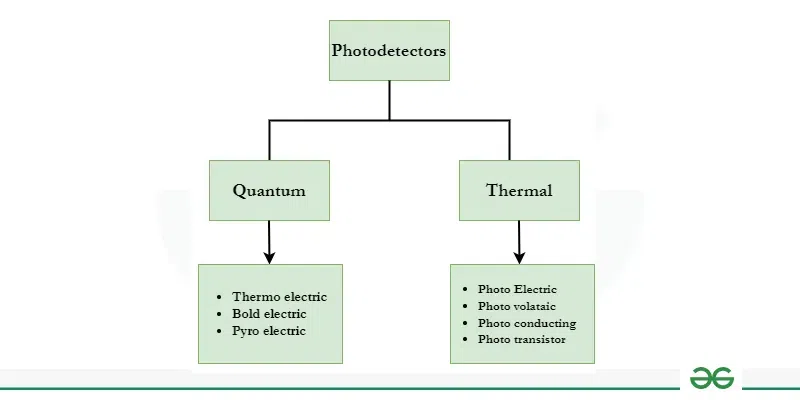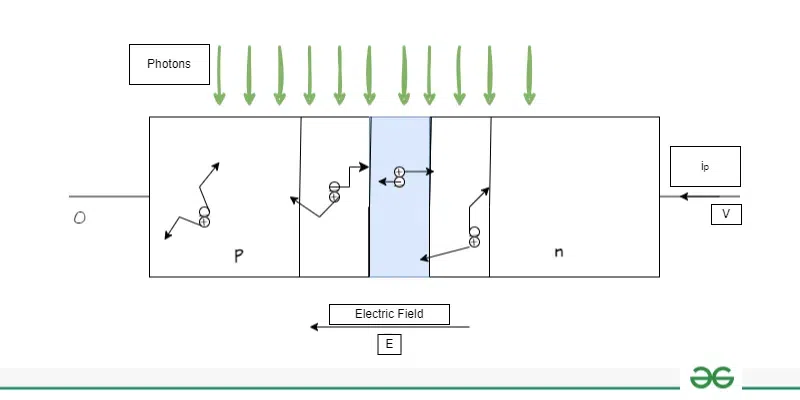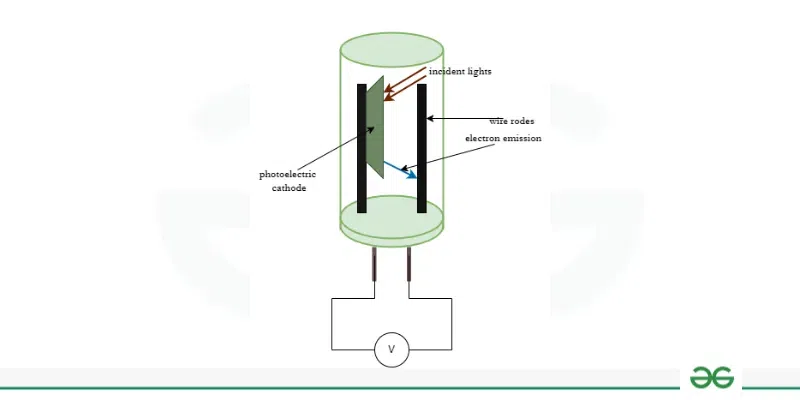A photo is nothing but light. A detector is nothing but a device that detects something. Therefore, we can directly conclude that a photodetector can be defined as a device that is used to detect light radiations by absorption. In this Article, We will be going through Photodetector, We will start our Article with What is Photodetector?, Then we will go through its brief Working, then we will go through its properties and go through all the types, At last, we will conclude our Article with Advantages, Disadvantages and Some FAQs.
What is Photodetector ?
Photo means light. A detector is a device that detects something. So, a photodetector can be defined as a device that is used to detect light radiations by absorption. It converts light pulses(or radiations) energy into electrical signals in the form of current & voltage. Sometimes, it is also called photosensors. As the name implies, it detects incident photons or radiations by absorbing the incident lights. The principle behind this process is known as photodetections.
Characteristics of Photodetector
- The detector should be sensitive.
- It should have a fast response.
- It should have the ability to detect a considerable range of wavelengths, ƛ.
- The electrical energy produced by the detector must be directly proportional to the transmitted intensity of the radiation.
Structure of Photodetector
The structure of a photodetector is similar to a photodiode:
When the incident radiation falls on the surface of the material of the photoconductor the photons present in the light are absorbed by the surface material which then next generates newly charged particles as electron-hole pairs which are further responsible for the production of electrical signals.
The suitable material use for making photodetector is semiconductor. Graphene (an allotrope of Carbon) is best known material for making of photodetectors.
Working of Photodetector
The basic principle of the photodetector is that when an incident light or radiation falls on the surface of detector and get absorbed, it converts it into electrical signals.

Reversed biased P-N junction
Photodetector acts as a reversed biased p-n junction. Let’s understand how the photodetector works-
There are three process works in the operation of the photodetector:
- Absorption
- Transportation of Carriers
- Extraction of Carriers As Photocurrent
Absorption
In this process, the light energy falls on the photodetector which gets absorbed by it. As we know light carries small packets of energy known as photons which means several photons are absorbed by the photodetector. Due to this,
• There is the generation of charged carriers in the device.
• These carriers are the electron-hole pairs (e- and h+).
Transportation of Carriers
In this process, the generated charge carriers get transported across all the absorption regions. In some photodetectors, a gain is provided to the charged carriers which means there is multiplication of photons which increases during the transportation.
Extraction of Carriers As Photocurrent
After the successful transportation of charged particles (electron-hole pairs), the collection of these carriers is done and the current as an electrical signal flows through the external circuit.
The current is generated mainly because of the photons that fall on the photodetector, that is why it is also called a photocurrent.
Classes of Photodetector

Classification of Photodetector
Based on their uses, there are two principal classes of photodetectors commonly which are common in used:
- Thermal Detectors
- Photoelectric Detectors
Thermal Detectors
In this class of detectors, when incident light falls on the surface of the detector, it leads to temperature rise which is measured. It operates by converting charged carriers’ energy into heat.
The temperature raise is directly proportional to the amount of light absorbed by the detector.
It is mainly used for detecting infrared radiation.
However, most of the thermal detectors are low in efficiency and require more time to show temperature variation. That is why it is not suitable for most photonic applications.
Photoelectric detectors
In this class of detectors, when the light falls on the surface of material then there is absorption of photons which results directly in an electronic transition to a higher energy level. Due to this, there are generations of moving charged carriers(electron-hole pairs).
The operating principle of these detector is photo effect.
Under the effect of an electric field, these moving charged carriers produce electrical signals in the form of electric current.
These detectors are widely used for photonic applications.
Properties of Photodetector
There are several properties of photodetector describes as follow:
- Responsivity
- Quantum Efficiency
- Dark Current
- Spectrum Response
- Response Time
- Gain
- Noise Equivalent Power
- Frequency Bandwidth
- Detectivity
Responsivity
It is defined as the power output divided by the total incident power input.
[Tex] \frac{v}{P \times A} in {\frac{V}{W}}
[/Tex]
where
V =output voltage signal
P= radiation power
A= area of detector surface.
Quantum Efficiency
It is defined as the ratio of the number of charge carriers that are generated to the number of each photon.
[Tex]Quantum efficiency,\eta=\frac{no of charge camers generated}{no of absorbed incident photons}
[/Tex]
There are two type of quantum efficiency: Internal quantum efficiency and external quantum efficiency.
- Internal quantum efficiency: It is the number of charge carriers generated over number of incidence photons.
- External quantum efficiency: It is the number of carriers crossing the electrode over the number of incidence photons.
Dark Current
It is defined as a photocurrent that flows even in the absence of the incident light.
Spectrum Response
It is defined as the range of spectrum over which the photodetector is over specified.
Response time
It is defined as the speed or response of the photodetector in the form of a function of the frequency of photon pulses.
Gain
It is defined as the ratio of output photocurrent to the total input current produced by the charge carriers. Gain,G should always be greater than 1.
G>1
Noise Equivalent Power
It is defined as the noise photocurrent divided by the peak radiant sensitivity.
Frequency Bandwidth
It is defined as the modulation frequency when the responsivity reduces by 3dB.
Detectivity
It is defined as the inverse of noise equivalent power.
[Tex]D=\frac{f \times a}{p} in \frac{cm \times HZ}{W}
[/Tex]
where
P = noise power
f= frequency bandwidth.
Types of Photodetector
Many types of photodetectors are classified based on the mechanism of the absorption of photons, photoelectric effect, temperature effect and other emission effects.
These are also depend upon the type of material used and also the junctions that are found in the photodetector.
Some of the important photodetector types as follow:
- Photoconductors
- Photo Diodes
- Metal-semiconductor metal Photodiodes
- Phototransistors
- Phototubes
- PhotoMultiplier Tube
- Charge Coupled Device
Photo Conductors
When photons are absorbed by a semiconductor material when light falls on the surface of the material it leads to the generation of mobile charged carriers (electron-hole pairs). There is a rise in the conductivity of the material in proportion to the amount of photon flux. An electric field due to an external voltage source causes the transportation of electrons and holes which results in a measurable electric current in the circuit.
This type of detector operates by registering either the current produced by the photons i.e., photocurrent ip, which is proportional to the photon flux, or the voltage drop across a resistance as a load that is connected in series with the external circuit.

Photo Conductors
Photo Diodes
The PhotoDiodes can be Categorized as p-n Photodiodes,p-i-n Photodiodes and Avalanche Photodiodes.

Types of photodiodes
The Brief Explanation about these three are given below
p-n Photodiodes
It depends upon the photo generated charged carriers for their operation. A photodiode is a p-n junction whose current in reverse bias increases when the material absorbs photons. Since an electric field can only support in the depletion region of the p-n junction, photocarriers are desirable to generate in this region.

Photons (charged carriers) irradiating an ideal reverse-biased p-n photodiode detector.
So it is required to increase the length of depletion region for fast response.
p-i-n Photodiodes
As the name implies, these photodiodes consist of an undoped intrinsic layer between two highly doped p-n junctions. It gives better performance than the common photodiodes.
A high electric field is present in the depletion region of this photodiode causing newly generated charged carriers to separate and be collected across the reverse-biased junction. This leads to the flow of electric current in the external circuit.

p-i-n Photodiode
where Ec is the energy of the covalent band and Ev is the energy of the valence band.
Avalanche Photodiodes
In the case of p-n photodiodes and p-i-n photodiodes, the output photocurrent is very small because of the very limited gain. To provide a large gain, the avalanche photodiode is used. The reverse bias is applied to the photodiode is closer to the breakdown value.

Avalanche photodiode
It is also called Schottky-barrier photodiodes. These photodiodes are made from metal and semiconductor heterojunction. A thin semi-transparent metal film is used in place of the p-type or n-type layer in the p-n junction photodiode. The thin film is mostly made of a metal-semiconductor alloy that acts like a metal. The Schottky barrier photodiodes have fast response and large operating bandwidth.
PhotoTransistors
Phototransistor is Photodiode + transistor. It is a semiconductor device having three terminals. It also used to convert incident light into photocurrent. The incident light( or radiation) falls on the base terminal and after that, it is converted into photocurrent which flows through collector and emitter. The transistor is used with photodiode because the current produced by the photodiode is low, that is why transistor is used to amplify the current.

p-n-p phototransistor & n-p-n phototransistor
Structure of phototransistor is same as transistor as above. The light falls on the base terminal as shown by arrow in fig which after converts into current.
PhotoTubes
In this device, it emits negative charge carriers i.e, electrons from a photosensitive negative charged cathode when it stike by visible or UV radiations. Electrons e– flow through a vacuum to an anode to produce current which is proportional to radiation intensity.

PhotoTubes
PhotoMultiplier Tube
It is very sensitive device in which electrons emitted from photosensitive cathode strike a second surface called as dynode. Dynode is positive +ve with respect to the original cathode. Electrons are this accelerated and can knock out more than one electron from the dynode.
The above process is repeated several times, so more than 106 electrons e–s are finally collected for each photons striking the first cathode surface. So more amount of photocurrent we get.
Charge Coupled Device
A charge-coupled device (CCD) is termed as most sensitive photodetectors. A charge coupled device is a device for the movement of electrical charge within the device to an area where charge can be manipulated. It is an IC(integrated circuit) having one array of linked, or coupled, capacitors. With the external circuit connection, every capacitor transfer their charge to the neighbor capacitors. It is majorly used in the image processing technology.
Comparison Between Photodetector and Photodiode
Photodetector
| Photodiode
|
|---|
Photodetector is a device which sense light radiation.
| Photodiode is a photodetector but it also detects the light intensity.
|
It is used to detect light radiations.
| It is light sensitive diode made of semiconductor.
|
It does not have amplifier to detect the light.
| Photodiodes have amplifiers connected in them for the detection of light having low level of intensity.
|
It is made of compound semiconductor having 0.73eV band gap.
| It is made of p-type. n-type, or p-n type of semiconductor junctions. Sometimes, It also have intrinsic junction.
|
Its response time is slow.
| Its response time is fast.
|
Advantages and Disadvantages of Photodetector
Given Below are Advantages and Disadvantages of PhotoDetector :
Advantages
- They are cost-effective, require less space and are light in weight.
- Less noise is generated in the output.
- They have high charged carriers(photons) detection efficiency and operational speed.
- They have a long duration of lifespan.
- Quantum efficiency is high.
Disadvantages
- They have a small limit of internal gain (almost negligible).
- The response time is very slow.
- The depletion region where the electric field is present is small.
- It requires an external voltage source.
- Output photocurrent is less.
Applications of Photodetector
These are the following applications of photodetectors:
- Photodetector is used in the different applications of optoelectronics in our daily life like TV remote.
- It is used in optical communications, radiometry and photonic applications.
- It is used in laser printing, displays and optical data recording.
- It is used in measuring of optical power and luminous flux of the lights.
- It is used in also vision scanners and for security purposes.
- It is also used in different types of microscopes & optical devices.
Conclusion
In this article, we learned and got the detailed knowledge about photodetector. This article categorised based on the topics including working, classes, types, characteristics , merits and demerits of photodetector.
FAQs on Photodetector
What is Photosensor?
A photosensor or photodetector is a type of optoelectronic device that is used to convert light energy or radiation into electric signals.
Which is the best material used for making photodetector?
Graphene is the best material for making photodiodes. It is an allotrope of carbon.
What are the steps involved in the working of a photodetector?
A photodetector operates in three steps-
- Absorption of photons.
- Transportation of newly generated charge carriers.
- Production of photocurrent from the charged carriers.
What do you mean by dark current?
A photocurrent that flows even in the absence of incident light is termed a dark current.
Why Schottky-barrier photodiode is useful other than p-n or p-i-n photodiodes?
The response time and operating speed of the Schottky photodiode is faster than the other photodiodes.
Share your thoughts in the comments
Please Login to comment...